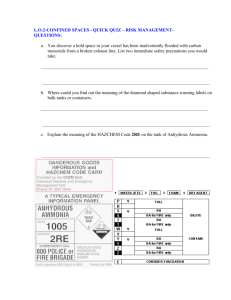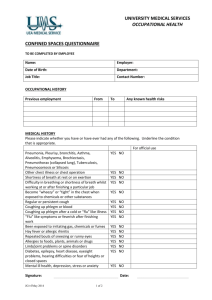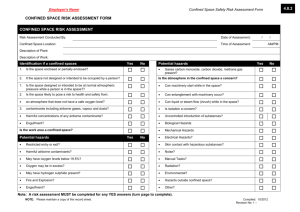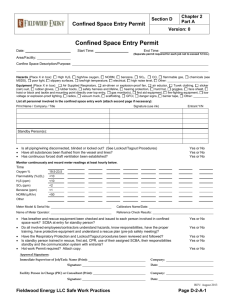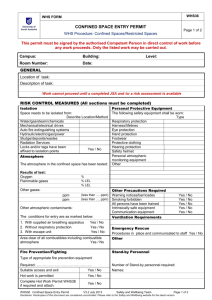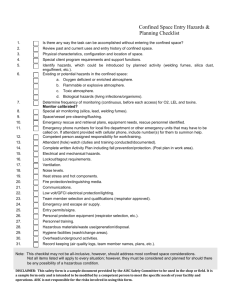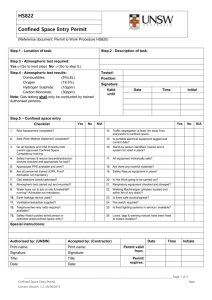Confined Space Entry
advertisement
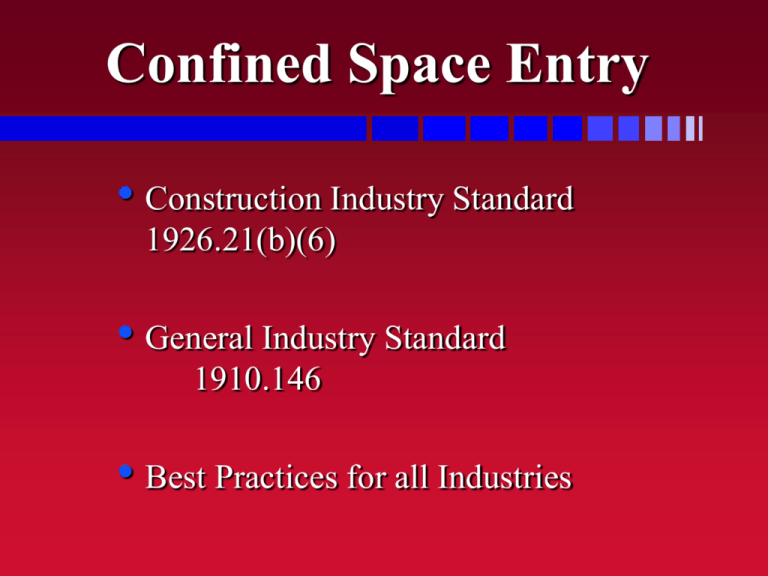
Confined Space Entry • Construction Industry Standard 1926.21(b)(6) • General Industry Standard 1910.146 • Best Practices for all Industries Construction Industry Standard All employees required to enter into confined or enclosed spaces shall be instructed as to the nature of the hazards involved, the necessary precautions to be taken, and in the use of protective and emergency equipment required. The employer shall comply with any specific regulations that apply to work in dangerous or potentially dangerous areas. Typical Confined Spaces • Boiler, Degreaser, Furnace • Pipeline, Pit, Pumping Station • Reaction or Process Vessel, Mills • Septic Tank, Sewage Digestor • Silo, Storage Tank, Barges • Sewer, Utility Vault, Manhole • Trenches, Shafts, Caissons How to Identify Confined Spaces • Limited Openings for Entry and Exit • Unfavorable Natural Ventilation • Not Designed for Continuous Worker Occupancy Categorizing Work Space * Space large enough to enter &; * Limited or Restricted entry or exit &; * Not designed for continuous worker occupancy. YES PermitRequired Confined Space NO Not a confined Space Confined Space Hazardous Atmosphere YES Or Engulfment Hazard Or Configuration Hazard Or Any other recognized serious hazard Non NO Permit Required Space Limited Openings for Entry/Exit • Openings as small as 18 inches in diameter. • Difficult to enter with SCBA or other life• • saving equipment. Difficult to remove downed worker in folded up or bent over position. Exit from large openings may be difficult due to presence of ladders, hoists, etc. Unfavorable Natural Ventilation • Lack of air movement in and out of the • • • space can create an atmosphere much different than the outside atmosphere. Deadly gases can be trapped inside. Organic materials can decompose. May not be enough oxygen due to presence of other gases or chemical reactions such as rusting. Not Designed for Continuous Worker Occupancy • Most confined spaces are not designed to • • • • enter and work in on a regular basis. Designed to store a product. Enclose materials or processes. Transport products or substances. Occasional worker entry for inspection, repair, cleanup, maintenance, etc. Dangerous Combinations • Presence of all three confined space • • • characteristics can complicate the situation. Working in and around the space. Rescue operations during emergencies. Worsened conditions due to work activities: – Welding and cutting, use of bonding agents – Cleaning with solvents, use of other chemicals – Use of gas-powered equipment Hazards of Confined Spaces • Oxygen Deficient Atmospheres • Oxygen Enriched Atmospheres • Flammable Atmospheres • Toxic Atmospheres • Temperature Extremes • Engulfment Hazards • Noise, Slick/Wet Surfaces, Falling Objects Oxygen Deficient Atmospheres 19.5 % 15 - 19% 12-14% 10-12% 8-10% 6-8% 4-6% Minimum acceptable oxygen level. Decreased ability to work strenuously. Impair coordination. Early symptoms. Respiration increases. Poor judgment. Respiration increases. Lips blue. Mental failure. Fainting. Nausea Unconsciousness. Vomiting. 8 minutes - fatal, 6 minutes - 50% fatal 4-5 minutes - possible recovery. Coma in 40 seconds. Death Oxygen Enriched Atmospheres • Oxygen level above 21%. • Causes flammable and combustible • • • • materials to burn violently when ignited. Hair, clothing, materials, etc. Oil soaked clothing and materials. Never use pure oxygen to ventilate. Never store or place compressed tanks in a confined space. Flammable Atmospheres • 2 Critical Factors: – Oxygen content in the air. – Presence of a flammable gas, or vapor – Presence of dust (visibility of 5’ or less) • Proper air/gas mixture can lead to explosion • Typical Ignition Sources: – Sparking or electric tool. – Welding / cutting operations. – Smoking Toxic Atmospheres • Product stored in a confined space: » Gases released when cleaning. » Materials absorbed into walls of confined space. » Decomposition of materials in the confined space. • Work performed in a confined space: » Welding, cutting, brazing, soldering. » Painting, scraping, sanding, degreasing. » Sealing, bonding, melting. • Areas adjacent to a confined space. Hydrogen Sulfide • Decomposition of materials. Human waste. • Rotten egg odor at low concentrations. • Possibly no warning at high concentrations. PPM Effect 10 ppm 50 - 100 200 - 300 500 -700 >1000 Permissible Exposure Level Mild Irritation - eyes, throat Significant Irritation Unconsciousness, Death Unconsciousness, Death Time 8 Hours 1 Hour 1 Hour 1/2 - 1 Hour Minutes Carbon Monoxide • Odorless, Colorless Gas. • Combustion By-Product. • Quickly collapse at high concentrations. PPM Effect 50 200 600 1000-2000 1000-2000 1000-2000 2000-2500 Permissible Exposure Level Slight headache, discomfort Headache, discomfort Confusion, nausea, headache Tendency to stagger Slight heart palpitation Unconsciousness Time 8 Hours 3 Hours 1 Hour 2 Hours 1 1/2 Hours 30 Min. 30 Min. Temperature Extremes • Extremely hot or cold temperatures. • Steam cleaning of confined spaces. • Humidity factors. • Extremely cold liquids. • Work processes inside the confined space • can increase temperature extremes. Personal protective equipment. Engulfment Hazards • Loose, granular materials stored in bins and • • • hoppers - grain, sand, coal, etc. Crusting and bridging below a worker. Flooding of confined space. Water or sewage flow. Other Hazards • Noise » Amplified due to acoustics within the space. » Damaged hearing, affect communication. • Slick / Wet Surfaces » Slips and falls. » Increased chance of electric shock. • Falling Objects » Topside openings expose workers inside confined space to falling objects. Testing The Atmosphere • Verify presence of safe work atmosphere. • Test all areas of a confined space. – Top, Middle, Bottom • Methane is lighter than air. • Carbon Monoxide is the same as air. • Hydrogen Sulfide is heavier than air. • Oxygen Deficiency. Ventilation • First option to correct problems. • Must be aware of hazards you are trying to • • • correct in the confined space. Air intake in a safe location to draw fresh air only. Continuous ventilation whenever possible. Retest the confined space before entry. Isolation • Locking and tagging out electrical sources. • Blanking and bleeding pneumatic and • • • • hydraulic lines. Disconnecting mechanical drives and shafts. Securing mechanical parts. Blanking sewer and water flow. Locking and tagging out shutoff valves. Respirators • Air-Purifying Respirators – Filter dangerous substances from the air. – Must know the type and amount of hazardous substance present in the confined space. – NEVER use with oxygen deficiency! • Air-Supplying Respirators – Deliver a safe supply of breathing air from a tank or an uncontaminated area nearby. – Must be adequately monitored. Standby / Rescue • Worker assigned to remain outside the • • • confined space and be in constant contact with the workers inside. Know emergency rescue procedures. 50% of workers who die in confined spaces are would-be rescuers. Trained in use of emergency rescue equipment and PPE. Permit Entry Systems • Written permit signed by entry supervisor. • Verifies pre-entry precautions have been • • • taken and the space is safe to enter. Posted at entry to confined space. Specifies apparent hazards and corrective actions taken prior to entry. Requires termination of permit when task is completed or when new conditions exist. Entry Permit Requirements • Date, location, and name of confined space. • Purpose of entry and known hazards. • Duration of entry permit time. • Authorized entrants, attendants, supervisors. • Air testing results - signature of tester. • Protective measures to be taken. » Ventilation, Isolation, Flushing » Lockout / Tagout, Purging Entry Permit Requirements • Name and phone numbers of rescue and • • emergency services. Communication procedures. Special equipment and procedures. – – – – Personal protective equipment. Alarm procedures. Rescue equipment. Respirators. Training and Education • All workers who must enter confined spaces • All attendants and rescue team members. • Prior to initial work assignment. • Retraining: » Job duties change. » Change in permit-space program. » New hazards are present. » Job performance indicates deficiencies.
